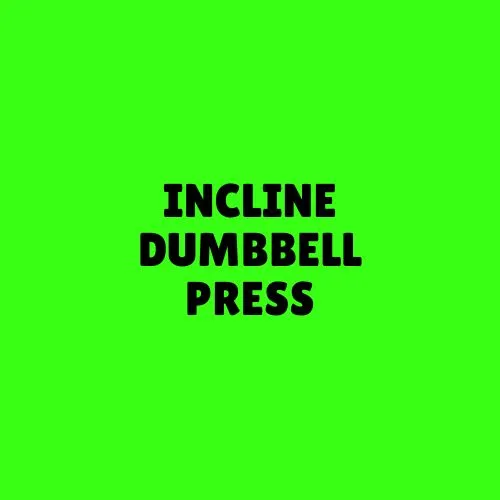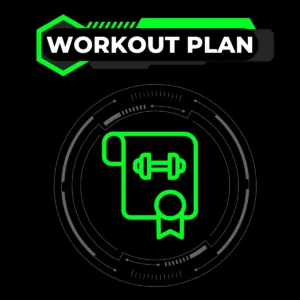Introduction
Ready to build a chest that turns heads? The incline dumbbell press is your golden ticket to sculpting that coveted upper pecs definition while boosting functional pushing strength. Whether you’re prepping for beach season or aiming to crush your bench PR, this exercise separates the casual lifters from the dedicated athletes. As Arnold Schwarzenegger once said:
‘The last three or four reps is what makes the muscle grow. This area of pain divides a champion from someone who is not a champion.’
Perfect your angle, grip those DBs tight, and let’s decode why this movement belongs in your Exercise Library staples.
Exercise Review
| Target Muscle Group | Upper Chest (Clavicular Pectoralis) |
|---|---|
| Exercise Type | Strength, Hypertrophy |
| Equipment Needed | Dumbbells, Incline Bench |
| Force Type | Push |
| Training Level | Intermediate to Advanced |
| Supporting Muscles | Anterior Delts, Triceps, Serratus Anterior |
| Mechanics | Compound |
| Primary Focus | Muscle Growth, Strength Development |
| Typical Duration | 45-90 seconds per set |
| Variation Options | Neutral Grip, Alternating Arm, Superset with Flyes |
Primary Muscle Groups Worked
The db incline chest press lasers in on your upper pectoral fibers like no other movement. When you set that bench between 30PAC-45PAC°, you’re specifically targeting the clavicular head of your pecs – the ‘shelf’ muscle that gives your chest that full, armor-like appearance. Research from the Journal of Strength and Conditioning shows incline pressing activates 5PAC% more upper pectoral fibers compared to flat bench variations.
But it’s not just about aesthetics. Strengthening this area improves your performance in overhead sports – think basketball rebounds or volleyball spikes. The movement pattern also translates to real-world pushing motions like lifting objects onto high shelves or pushing yourself up from an inclined position.
Pro tip: Squeeze your chest at the top like you’re trying to crush a walnut between your pecs. This mind-muscle connection increases EMG activity by up to 20PAC% according to NSCA studies.
Secondary Muscle Groups Engaged
While the dumbbell incline bench presses mainly torch your upper chest, it’s a team effort workout. Your anterior delts act as co-pilots, stabilizing the movement and preventing shoulder roll-forward. Triceps jump in during the lockout phase, especially if you focus on full extension at the top.
Don’t forget the unsung heroes: Your serratus anterior (those finger-like muscles along your ribcage) work overtime to stabilize your scapula. Strengthening these helps prevent shoulder impingement and improves your bench arch. Even your core engages isometrically to maintain proper bench positioning – no cheaty back arches allowed!
For complete chest development, pair this with decline variations to hit lower pec fibers and incline flyes for stretch-mediated growth.
Instructions
Set up like a pro: Adjust your bench to 30PAC-45PAC° – steeper angles shift more work to shoulders. Grab DBs with a full grip, kick them up to your knees, then lie back while maintaining neutral wrist alignment. Plant your feet firmly, squeeze your glutes, and retract your scapula like you’re trying to hold a pencil between your shoulder blades.
Lower the weights with control to about chin level, keeping elbows at a 45PAC° angle from your torso. Press up explosively while maintaining slight elbow softness at the top – no joint locking! Breathe out on exertion, inhale during the eccentric phase. Aim for 3-4 sets of 8-12 reps using progressive overload principles.
Advanced technique: Try a 2-second pause at the bottom position to eliminate momentum and increase time under tension. Your chest will scream mercy while your gains skyrocket!
Benefits
The incline bench db press isn’t just another chest exercise – it’s a functional strength builder with carryover to multiple sports. Unlike barbell variations, DBs allow greater range of motion and unilateral strength balancing. A study by ACE Fitness found dumbbell presses improve joint stability 23PAC% more than barbell versions.
For bodybuilders, the stretch at the bottom position creates micro-tears that lead to hypertrophic adaptations. Powerlifters use incline DB press as an accessory move to strengthen their bench press weak points. Even MMA fighters benefit from the shoulder stability and pressing power development.
Bonus perk: The neutral hand position reduces shoulder strain compared to barbell pressing, making it safer for athletes with rotator cuff concerns when performed correctly.
Variations
Keep your workouts fresh with these twists on the classic incline dumbbell press:
1. Neutral Grip Press
Palms facing each other reduces shoulder stress while hammering triceps
2. Alternating Arm Press
Unilateral focus corrects muscle imbalances – great for rehab scenarios
3. Machine Incline Press
Use machine versions for injury-safe overload training
4. Superset with Flyes
Pair with incline flyes for brutal chest pump
Common Mistakes
Avoid these gains-killers: Overarching your lower back (keep core tight), letting elbows flare beyond 60PAC°, and using excessive weight that compromises form. Many athletes mistake the incline press for a shoulder exercise – if your anterior delts burn out first, reduce the bench angle.
Watch for asymmetrical pressing – DBs should move in unison. If one arm races ahead, deload and focus on mind-muscle connection. Never bounce weights off your chest – control the eccentric to prevent pec tears.
Pro fix: Film your side profile – the DBs should follow a slight J-curve path, not straight up-down. Your forearms should remain vertical throughout the movement.
Safety and Precautions
Always warm up with band pull-aparts and light push-ups to activate stabilizers. Use a spotter for heavy sets – DBs can become unstable at failure. Those with shoulder impingement issues should stick to lower inclines (~30PAC°) and neutral grips.
Never skip wrist wraps if going heavy – the angled position increases shear forces. If you feel anterior shoulder pain mid-set, abort immediately and reassess form. Pregnant lifters should avoid supine positions post-first trimester – opt for seated machine versions instead.
Equipment Needed
You’ll need:
- Adjustable incline bench (preferably with foot holders)
- Dumbbells with secure grip handles
- Weight plates for progressive overload
- Spotter for heavy attempts (optional but recommended)
Pro tip: Chalk your hands – sweaty palms with angled DBs are an accident waiting to happen. Check out our Equipment Guides for best bench recommendations.
Alternative Exercises
Mix these into your chest days:
- Flat Bench Press – Classic mass builder
- Incline Barbell Press – For maximal weight overload
- Pec Deck – Isolation finisher
- Chest Dips – Bodyweight powerhouse
Other Names
Also known as: DB incline press, dumbbell incline bench presses, incline bench db press, İncline dumbbell press (common misspelling)
Conclusion
The incline dumbbell press isn’t just an exercise – it’s a cornerstone of upper body development. Whether you’re chasing that superhero chest look or building functional strength for sports, this movement delivers. Remember: Progress happens when the weights get heavy and the reps get gritty. Stick with it, track your lifts using our progress tracker, and watch your upper body transform!
FAQ
How often should I do incline dumbbell press?
2x weekly max – chest muscles need 48PAC-72 hrs recovery. Pair with other presses in a structured program.
Can beginners try this exercise?
Absolutely! Start light (15PAC-20PAC lb DBs) and focus on form. Consider machine variations first if unstable.
What’s better – incline DB or barbell press?
DBs for muscle balance/stability, barbell for max strength. Rotate both in your program.
How many reps for muscle growth?
6PAC-12 reps/set with 70PAC-85PAC% 1RM. Use our rep calculator to dial it in.
Can I substitute this if I don’t have a bench?
Use an adjustable bench or sturdy decline (flipped) – never substitute with unstable surfaces like yoga balls.



